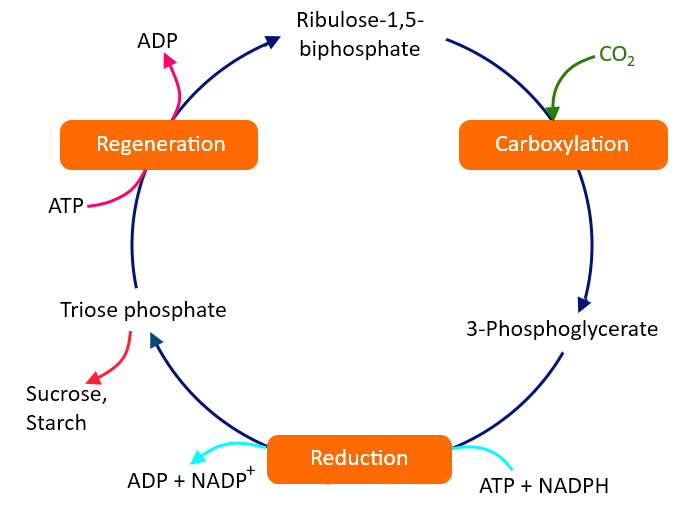
Carbon in carbon dioxide is radioactively labeled. The product in which radioactive carbon can be traced in ${ C }_{ 3 }$ plants is
(a)PEP
(b)RuBP
(c)OAA
(d)PGA
Answer
559.2k+ views
Hint: A three-carbon molecule is a substance in which radioactive carbon can be traced in ${ C }_{ 3 }$ plants. They are not part of the family of carboxylases. In the Krebs cycle, they are not an intermediate product.
Complete answer:
Calvin's Experiment:
The suspension of unicellular algae is inactivated after different illumination periods and the contents of the cells are collected. By paper chromatography, the compounds in a drop of the extract are then isolated.
The identity of each substance can simply be determined by comparing its location with the positions held under the same conditions by known substances. Or, it is possible to cut from the sheet a fragment containing the spot and chemically examine it.
A sheet of X-ray film is placed next to the chromatogram to determine which, if any, of the substances separated by the chromatogram are radioactive. When dark spots (due to the radiation emitted by the $_{ }^{ 14 }{ C }$ atoms) appear on the film, their location can be associated with the location of the chemicals in the chromatogram. Using this autoradiography technique, Calvin noticed that within 30 seconds after the beginning of photosynthesis, $_{ }^{ 14 }{ C }$ turned up in glucose molecules. However, the radioactivity was concentrated in many other, smaller, molecules when he allowed photosynthesis to continue for only 5 seconds.
The dark spots display the radioactive compounds formed by the Scenedesmus green algae after 10 secs (left) and 2 minutes (right) of photosynthesis. The algae were supplied with $_{ }^{ 14 }{ C }$ labeled carbon dioxide, a radioactive carbon isotope. Most of the radioactivity is contained in 3-phosphoglyceric acid after 10 seconds. Phosphorylated 6-carbon sugars (glucose and fructose) as well as a number of amino acids were synthesized within 2 minutes. The tiny rectangle and circle mark the spots where the cell extract was applied (lower right-hand corners).
So, the correct answer is, ‘PGA’.

Note: Phosphoglyceric acid (PGA) is the first relatively stable compound produced in the Calvin cycle following the fixation of carbon dioxide in ${ C }_{ 3 }$ plants. It is a 3-carbon organic acid produced during glycolysis. As carbon dioxide mixes with ribulose diphosphate, the first product, an unstable 6-carbon compound, is formed.
Complete answer:
Calvin's Experiment:
The suspension of unicellular algae is inactivated after different illumination periods and the contents of the cells are collected. By paper chromatography, the compounds in a drop of the extract are then isolated.
The identity of each substance can simply be determined by comparing its location with the positions held under the same conditions by known substances. Or, it is possible to cut from the sheet a fragment containing the spot and chemically examine it.
A sheet of X-ray film is placed next to the chromatogram to determine which, if any, of the substances separated by the chromatogram are radioactive. When dark spots (due to the radiation emitted by the $_{ }^{ 14 }{ C }$ atoms) appear on the film, their location can be associated with the location of the chemicals in the chromatogram. Using this autoradiography technique, Calvin noticed that within 30 seconds after the beginning of photosynthesis, $_{ }^{ 14 }{ C }$ turned up in glucose molecules. However, the radioactivity was concentrated in many other, smaller, molecules when he allowed photosynthesis to continue for only 5 seconds.
The dark spots display the radioactive compounds formed by the Scenedesmus green algae after 10 secs (left) and 2 minutes (right) of photosynthesis. The algae were supplied with $_{ }^{ 14 }{ C }$ labeled carbon dioxide, a radioactive carbon isotope. Most of the radioactivity is contained in 3-phosphoglyceric acid after 10 seconds. Phosphorylated 6-carbon sugars (glucose and fructose) as well as a number of amino acids were synthesized within 2 minutes. The tiny rectangle and circle mark the spots where the cell extract was applied (lower right-hand corners).
So, the correct answer is, ‘PGA’.

Note: Phosphoglyceric acid (PGA) is the first relatively stable compound produced in the Calvin cycle following the fixation of carbon dioxide in ${ C }_{ 3 }$ plants. It is a 3-carbon organic acid produced during glycolysis. As carbon dioxide mixes with ribulose diphosphate, the first product, an unstable 6-carbon compound, is formed.
Recently Updated Pages
Master Class 11 Economics: Engaging Questions & Answers for Success

Master Class 11 English: Engaging Questions & Answers for Success

Master Class 11 Social Science: Engaging Questions & Answers for Success

Master Class 11 Biology: Engaging Questions & Answers for Success

Class 11 Question and Answer - Your Ultimate Solutions Guide

Master Class 11 Business Studies: Engaging Questions & Answers for Success

Trending doubts
10 examples of friction in our daily life

One Metric ton is equal to kg A 10000 B 1000 C 100 class 11 physics CBSE

Difference Between Prokaryotic Cells and Eukaryotic Cells

1 Quintal is equal to a 110 kg b 10 kg c 100kg d 1000 class 11 physics CBSE

Explain zero factorial class 11 maths CBSE

What is a periderm How does periderm formation take class 11 biology CBSE




